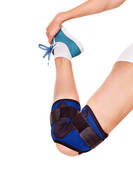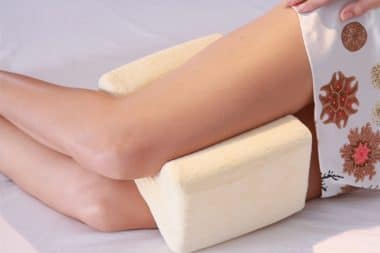Sprains are almost as painful as breaks and can actually be stretched or torn ligaments. These ligaments connect your bones to one another and keep them from moving out of their proper places. Ankle sprains are fairly common and take place when you rotate your ankle too far out of the natural position. This can happen when walking, jumping, or when you fall. The majority of ankle sprains occur doing sports or when running or walking on uneven surfaces.
You may feel pain or tenderness, swelling and bruising or numbness in your foot with a sprained ankle. You often have the inability to walk or bear weigh on your ankles and there is extreme stiffness. How bad an ankle sprain hurts is dependent on how the ligaments are stretched or torn. If you have a mild sprain you may not have pain or swelling and the ligaments might only be slightly stretched. If, however you have a severe sprain you may have actually torn your ligaments and the joint may be swollen. This type of sprain is very painful.
Causes of Ankle Sprains
When you make a rapid sifting movement with your foot planted, you cause your ankle to roll outward and the foot to turn inward. This causes the ligaments on the outside of your ankle to stretch and tear. You can also roll your ankle inward and the foot outward. The will damage ligaments on the inside of your ankle.
Ankle sprains can be mild to severe and this is dependent on how the ligament is damaged and how many ligaments are torn. You may find that in a mild sprain the ankle is tender and swollen, but it feels stable and you can walk; usually limping and with pain. If you have sprained your ankle seriously you will find that the ankle is unstable and feels wobbly. You can’t walk since the ankle gives way and is very painful. You need to call for help to get up and move.
Diagnosis and Treatment
Physicians can diagnosis an ankle sprain by asking a few simple questions and then examining your ankle. You may need to have an x-ray taken to make sure it is not fractured or broken.
If the diagnosis is a sprain, the RICE treatment or approach to healing your ankle is recommended.
- Rest your ankle. Use crutches for as long as prescribed.
- Ice on your ankle will decrease the swelling and the pain. Bruising and muscles spasms will also be decreased. Use ice packs, ice massages or plastic bags of peas or corn to your ankle. Keep using this treatment for three days after the sprain.
- Compression or wrapping your ankle will keep the swelling and bruising to a minimum. You may be required to keep your ankle wrapped in an ace bandage for up to two days after the injury. It the pain and swelling is severe you may have to compress the site of the injury for up to a week.
- Elevations or raising our ankle above the level of your heart prevents the swelling from worsening. This will also help decrease bruising. Keep your ankle higher than the rest of your body for about three hours a day.
Depending on how serious the sprain is you may have other injuries that require additional treatment. You might need to use a brace or a padded plastic splint for up to ten days. A brace keeps your bones and injured ligaments from moving. This reduces the pain and helps with healing.
If your sprain is not serious you may have to stay off it for about three days. If the sprain is severe you may need special exercises to regain strength and avoid the chances of a fracture.
Generally medication is not prescribed for a simple sprained ankle. It is permissible to use acetaminophen or ibuprofen to help decrease the swelling and pain. Pain can be managed by using ice on your ankle. Do be careful however, the intense cold might damage nerves if you use ice too often or keep an ice pack in place for too long. Twenty minutes is usually the best length of time to leave ice on an ankle.
Wrap a sprained ankle by using a horseshoe shaped pad on the outside of your ankle joints. Using a figure eight or basket weave pattern, wrap an Ace or elastic bandage around your ankle leaving your heel exposed. You can strengthen your wrap with adhesive tape wrapped over the bandage. Do not wrap your ankle so tight that the blood flow is cut off.
You can begin using your ankle normally in several weeks. If you are an athlete you do need to take care that the injury is totally healed. You can bicycle, swim or run if you feel no pain during or after exercise. Do not pivot and twist your ankle for up to three weeks.
Prevention
Preventing re-injury to your ankle is important if you are an athlete or even just an active person. You can exercise your ankle by wearing a semi-rigid ankle brace or use special wraps that have hook and loop fasteners. Some athletes use air filled braces that help avoid re-injuries. Wearing high top athletic shoes may also help prevent ankle sprains. Elastic tape is not recommended since it gives too much around the joint.
To strengthen your ankle use the following exercises:
- Ankle circles. Move your ankle from side to side and up and down and around in circles as you sit on the floor. Do these at least three times per day in 10 circle sessions.
- Alphabet letters. Your big toe is your pencil and use it to write the letters of the alphabet in the air. Run through the entire alphabet at least three times a day.
- Toe Raises. Stretch your toes back toward you and keep your knees straight. Hold for 15 seconds and practice this exercise at least 10 times during a session.
- Heel Raises. Stretch your toes away from your body and keep your knees straight. Hold for 15 seconds and do at least 10 times a session.
- In and out. Move your foot inward until you can’t turn it any more or until there is excruciating pain. Hold for 15 seconds. Straighten and relax. Turn outward and hold for 15 seconds. Do this 10 times in both directions.
- Balance exercises. Balancing on a recently healed ankle will test the ankle’s strength. Place a chair on the side of your “good” leg. Stand on the injured foot for at least 30 seconds. (Keep you uninjured leg off the floor). Increase the time you can stand on our injured foot until you are up to three minutes at a time. Repeat as often as you can. Now try closing your eyes, let go of the chair, and balance. This will definitely test your ankle.
Just about everyone has twisted an ankle at some point. If your ankle swells and is painful, however, you have probably stretched the ligaments in your ankle. Do not think of ankle sprains as minor injuries. There are those with repeated or sever sprains that develop joint pain and weakness. You do need to treat a sprained ankle to prevent additional problems.







